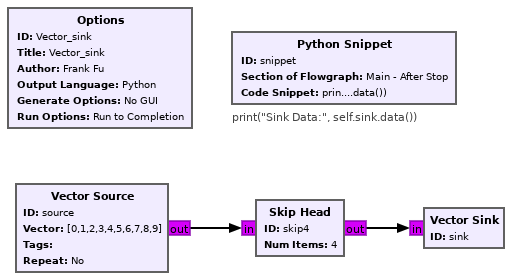Vector Sink: Difference between revisions
Jump to navigation
Jump to search
(Created page with "Category:Block Docs Category:Stub Docs This is the template for the "Page-per-block Docs". This first section should describe what the block...") |
(add Example Flowgraph) |
||
| (4 intermediate revisions by 3 users not shown) | |||
| Line 1: | Line 1: | ||
[[Category:Block Docs]] | [[Category:Block Docs]] | ||
Stores stream to a vector, useful if you’re running for a short time, for example | |||
in a test. You can access that data using snk.data() after tb.run() has completed. | |||
So something like: | |||
tb.run() | |||
time.sleep(10) | |||
my_data = tb.my_vec_snk.data() | |||
print("data: ",my_data) | |||
To extract data from a running flow graph use the probe blocks. | |||
tb.start() | |||
time.sleep(10) | |||
my_data = tb.my_probe_signal.level() | |||
print("data: ",my_data) | |||
== Parameters == | == Parameters == | ||
; Reserve Memory for Items | |||
: Reserve space in the internal storage for this many items; the internal storage will still grow to accommodate more item if necessary, but setting this to a realistic value can avoid memory allocations during runtime, especially if you know a priori how many items you're going to store. | |||
; | |||
: | |||
== Example Flowgraph == | == Example Flowgraph == | ||
[[File:Vector_sink_nongui.png]] | |||
[[File:Vector_sink_nongui_console.png]] | |||
<p>This flowgraph can be downloaded from [[Media:Vector_sink_nongui.grc]].</p> | |||
== Source Files == | == Source Files == | ||
Latest revision as of 15:24, 21 May 2025
Stores stream to a vector, useful if you’re running for a short time, for example in a test. You can access that data using snk.data() after tb.run() has completed.
So something like:
tb.run()
time.sleep(10)
my_data = tb.my_vec_snk.data()
print("data: ",my_data)
To extract data from a running flow graph use the probe blocks.
tb.start()
time.sleep(10)
my_data = tb.my_probe_signal.level()
print("data: ",my_data)
Parameters
- Reserve Memory for Items
- Reserve space in the internal storage for this many items; the internal storage will still grow to accommodate more item if necessary, but setting this to a realistic value can avoid memory allocations during runtime, especially if you know a priori how many items you're going to store.
Example Flowgraph
This flowgraph can be downloaded from Media:Vector_sink_nongui.grc.
Source Files
- C++ files
- TODO
- Header files
- TODO
- Public header files
- TODO
- Block definition
- TODO

